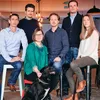Excel today, but also explore for tomorrow – innovation tips from Scott Anthony, author, ‘Dual Transformation’
Innovation author Scott Anthony joins us for an interview on business changes unleashed by entrepreneurs, responses from large incumbents, and opportunities for collaboration.
Scott Anthony is a senior partner at innovation consultancy Innosight, and co-author of Dual Transformation: How to Reposition Today's Business While Creating the Future (see my book review here). His other books are The Little Black Book of Innovation and The First Mile: A Launch Manual for Getting Great Ideas into the Market.

The core of the book revolves around the four mindsets of dual transformation: the courage to choose, clarity to focus, curiosity to explore, and conviction to persevere. In dual transformation for innovation, Transformation A is repositioning and improving the business model to maximise resilience (eg. Adobe moving from packaged software to SaaS).
Transformation B is creating a new growth engine (eg. Amazon adding cloud computing services, digital publishing, and streaming content on top of e-commerce). The Capabilities Link involves building on the relevant mix of critical assets, brand and scale, and managing the interface between the core and the new.
Scott joins us in this interview on the competition between startups and large incumbents, emerging disruptions, strategies for innovators, and the importance of organisational culture for success.
Edited excerpts below:
YourStory: In your last chapter, you identify five sectors ripe for disruption in the next few years. What types of Transformation B are you observing here?
Scott Anthony: I will highlight two sectors: banking and automotive. In automotive, many global manufacturers have moved quite aggressively to invest in sharing platforms and enabling technologies. Hundreds of billions are on the line as major manufacturers seek to simultaneously electrify current vehicles and create new business models.
In banking, you have Blackrock and JP Morgan Chase doing interesting work that has some parallels to Amazon Web Services in finance while challenger digital banks and fintech startups continue to grow.
YS: What are the typical challenges entrepreneurs face as they scale up their company from startup to large firm? How can they keep themselves open for waves of Transformation B in future?
SA: One quote that I think summarises the battles discussed in the last question, and really, almost every industry battle, is from Alex Rampell of venture capital firm Andreessen Horowitz: “The battle between every startup and incumbent comes down to whether the startup gets distribution before the incumbent gets innovation.”
The root of the challenge is that sometimes entrepreneurs assume their ocean will remain blue or their white space will remain uncolored, but increasingly the big companies are “getting innovation” and serving as formidable competitors. One key mindset shift then is to move from disrupting or disemboweling the big company to think about how to work with the big company. After all, small will always be faster than big, but big can be better than small!
YS: How should innovators strike that delicate balance between ‘Stick to your vision’ and ‘Adapt to a changed world’?
SA: I see no conflict between those two — once you recognise that every idea is partially right and partially wrong, you recognise the only way to achieve the vision is to adapt to a changed world. The military calls this “commander’s intent.”
You know what the vision and objective is, but the specific tactics to achieve it are left to people on the ground closer to the situation. In summary, firm in the vision, flexible in the approach.
YS: How should founders evaluate weak signals and anecdotal evidence which seem to contradict quantitative market trends?
SA: One of the most important things any innovator needs to do is to have clear hypotheses with detailed assumptions. That helps to filter and interpret different sources of data. It is also important to remember that often the quantitative data represents yesterday, and the weak signals represent tomorrow.
Looking for changes in the rate of change – the second derivative of change – is another tip. One of our former clients said he would pay attention to things that were doubling, no matter how small, because that meant something interesting was going on. As you can see, there is no single answer to this question!
YS: How does your framework connect to other models of innovation like lean startup, frugal innovation, and co-creation?
SA: Dual transformation is more of a broad strategy and leadership book. The models you mention are excellent tools to help do the next level of work required to make the strategy real. So, there is great compatibility between the two, particularly for ideas with Transformation B characteristics.
YS: Some companies seem to have formalised steps towards Transformation B by allowing employees to work on related side projects, eg. Google, 3M. Is this another effective way to test the waters before formally launching new offerings?
SA: I would say yes and no. Certainly bounded experimentation is a good way to learn about ideas. But the reality is creating a business is really hard. And if it is a side project, that runs the risk of being a science experiment that never scales. The key is to make sure that there is a plan to scale resources beyond testing the waters.
YS: How can social entrepreneurs and non-profit organisations make use of your framework?
SA: A good example is Settlement Music School, a not-for-profit music school in the East Coast of the United States. Settlement’s CEO Helen Eaton has driven Dual Transformation. Transformation A is rethinking how to use Settlement’s physical locations.
Transformation B is moving music education from the schools to the community in a range of innovative ways. Every organisation can think about these two vectors of change. Of course, they are under no legal requirement to drive Dual Transformation!
It can very well turn out there is significant room to advance against a mission simply by better execution. That’s great! But social entrepreneurs and non-profit organisations should at least ask whether there are opportunities to reinvent today and create tomorrow.
YS: From your journeys across Asia, what do you see as Asia’s innovation strengths and gaps?
SA: Asia is a big and diverse place. I would say the biggest strength is that companies are in many cases structurally positioned to take more of a longer-term perspective, which is necessary to drive meaningful change.
A second key strength is pure demographics — Asia already has most of the people, and over the next 20 years will have most of the wealth in the world. In terms of gaps, many companies are quite hierarchical. Innovation doesn’t always come from the top and requires the space to experiment and learn.
Failure is often a dirty word, and it is important to celebrate what Harvard Business School Professor Amy Edmondson calls “intelligent failure,” where an uncertain hypothesis is tested in a resource efficient way.
YS: Your framework for reinventing companies through Transformation B can also apply to individuals reinventing their careers. Have you developed some talent frameworks in this regard?
SA: Great question! This is still quite emergent but one way to identify Transformation B opportunities is to take a “future back” perspective. We have indeed applied that approach to individuals.
What do you imagine the world of 2030 looking like? What would you like to be doing in that world? What would be the path from here to there? That framing can help start the journey of personal transformation.
YS: How was your book received? What were some of the unusual responses and reactions you got?
SA: We have been incredibly pleased with the book’s reception. Perhaps the most gratifying thing has been to hear from people who used the ideas in unexpected ways.
For example, we heard from someone at one of world’s largest museums who said the book helped to frame up how to respond to shifting visitor expectations and new digital possibilities. It is always gratifying to see ideas translating to impact.
YS: In the time since your book was published, what are some notable new examples you have come across of Transformation A and B?
SA: Our consulting team at Innosight has now written two research reports providing additional examples, with a third on the way. Microsoft is an example that was not in the book that has really exploded under the thoughtful leadership of Satya Nadella.
A lesser-known example is Seek, an Australian company that has digitsed its core job listing business (Transformation A) and created a new online learning engine that provides services to universities (Transformation B).
YS: What is your current field of research in innovation? What is your next book going to be about?
SA: A lot of our work recently has been around how to create a culture of innovation. And that is the theme of my next book, which I am doing in conjunction with two Innosight colleagues and the Chief Data and Transformation Officer at DBS.
We are intersecting four streams: innovation, culture, behavioral psychology, and organisational design to create a practical playbook for culture change that sticks and scales. At least that is the aspiration! Draft One goes into our publisher this week, with a tentative publication date in the second half of next year.
YS: What is your parting message to the startups and aspiring innovators in our audience?
SA: Our definition of innovation is something different that creates value. The most important word in that definition is the first one: “something.” Everyone is capable of innovation success, but it requires the curiosity to question the status quo and the initiative to roll up your sleeves and do something.
Never forget Thomas Edison’s line: “Genius is one percent inspiration and 99 percent perspiration.” Start sweating!









